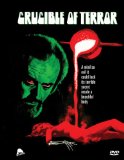Former pirate radio DJ Mike Raven plays Victor Clare (a case where the actor has a scarier name than the character he plays), reclusive artist who, one strongly suspects, has the unpleasant House-of-Wax-y propensity to pour molten metal on his models in order to bronze them. A group of characters with varying agendas gather at his Cornwall abode: his senile wife; his sexually ambivalent model; his weak, alcoholic son (Ronald Lacey, a long way from the menacing Nazi he would later play in Raiders of the Lost Ark) and impatient daughter-in-law; a neophyte art dealer and his girlfriend, Millie (Mary Maude). Victor becomes obsessed with Millie, determined make her his artistic muse. Meanwhile, the cast is being gruesomely bumped off one after the other.
Raven comes across very much as a poor man’s Christopher Lee. He has the height (more or less), he has a deep voice, and he even looks not unlike Lee. But he has none of the master’s screen presence, and isn’t as frightening as he clearly should be. Most of the film is a rather dull plod, with characters wandering about, flirting or sniping at each other, and repeating conversations ad nauseum. The murders come along every so often to spice things up, but given Victor’s obvious villainy, one might well wonder why the film is being so coy about the killings, and refusing to show us the killer.
Well, dear reader, the answer lies in the twist ending. Now, I am not going to spoil the ending, and while even indicating that there is a twist is itself a tiptoe into spoiler territory, I’m not giving away anything that isn’t already on the jacket copy. What I will say is this: that ending is why this film has three stars instead of two. Not because it’s a smart ending, or one that makes any real sense. Rather, this is a twist so wildly out of left field (even taking into account the clues that are sprinkled in throughout the film) that it enters the rarefied realm of the So Bad It’s Magnificent. That ending saves a rather pedestrian exercise in sub-sub-sub-Hammer horror/mystery and makes it truly, unmissably demented.
Video
There is no disguising the fact that this film is an older, low-budget exercise. The colours vary between the strong (in the foundary sequences) to a dull, brown wash (notably in some exterior scenes). Grain is noticeable, especially in the reds. The print is, for the most part, clean, sharp and free of damage, but there are two odd moments where everything slows to a jerky crawl, like a video game afflicted with a bad frame rate. The aspect ratio is 1.78:1 anamorphic widescreen.
Audio
Some age apparent here, too. The mono gets the job done, and is plenty loud, but there is some hum, and the dialogue has a tendency toward sibilance. About half an hour in, there’s a moment of very pronounced gurgling. That said, the dialogue is never muzzy, nor do any of the flaws make it incomprehensible.
Special Features
None.
Final Thoughts
This is a bare-bones offering, obviously, but it marks yet another resurrection of an obscurity, and that’s Point One it its favour. Point Two is the extreme eccentricity of that ending. Cult fans, you don’t be disappointed.





